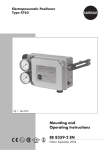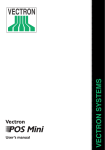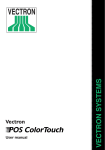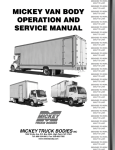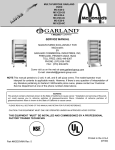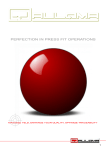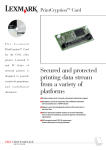Download Mounting and Operating Instructions EB 8368
Transcript
Mounting and Operating Instructions Limit Switch Type 3776 Fig. 1 Contents General notes Mounting Mounting to SAMSON Type 3278 Rotary Actuators Mounting to rotary actuators according to VDI/VDE 3845 – fixing level 1 Mounting to rotary actuators according to VDI/VDE 3845 – fixing level 2 Mounting to SAMSON Type 3277 Linear Actuators without positioner Mounting to SAMSON Type 3277-5 Linear Actuators (external) without positioner Mounting to SAMSON Type 3277-5 Linear Actuators (internal) without positioner Air connection Filter elements for air supply Exhaust air filters/degree of protection Restrictors Electrical connection Connecting cables Pilot valve/manual operation function Connecting diagrams Contacts Displacement of the switching point due to changes in temperature Inductive pick-ups Inductive double proximity switch Electric microswitches Certifications Certificate of Conformity PTB No. Ex-97.D.2107 Edition: July 1999 2 2 3 4 5 6 8 10 12 12 13 13 14 14 14 15 19 19 20 21 22 23 23 EB 8368 EN General notes Mounting m m The device may only be assembled, started up, and operated by experienced personnel familiar with this product. Proper shipping and appropriate storage of the device are assumed. In these Mounting and Operating Instructions, the term “experienced personnel“ refers to persons, who are able to evaluate the responsibilities assigned to them as well as recognize potential hazards due to their specialized training, knowledge, and experience as well as their special knowledge of the relevant standards. Staff handling/operating ex-proof devices in hazardous areas must be specially trained or instructed, i. e. authorized to handle/operate ex-proof devices. For technical data, ordering data, spare parts and accessories, see Data Sheet T 8368 EN. Before mounting to actuators, all relevant parts of the plant must be depressurized. In view of the high surface resistance, the device shall be mounted and serviced in hazardous areas, so that no electrostatic charging is to be expected. The coated screws in the enclosure must not be tampered with. Using mounting kits, the devices can be mounted to SAMSON Type 3278 Rotary Actuators, to rotary actuators according to VDI/VDE 3845 and to SAMSON Types 3277 and 3277-5 Linear Actuators. Then the relevant mounting instructions must be observed (see page 3 ff.). The devices can be mounted in any desired position to SAMSON Type 3277 Linear Actuators. The devices must not be mounted to rotary actuators or valves with NAMUR rib with the bottom of the enclosure upwards, to prevent water entering the enclosure. The exhaust air filter in the enclosure cover and the cable gland must be installed vertically downwards or, if this is not possible, horizontally. On mounting, it is important that a clearance of 300 mm minimum above the enclosure cover be observed. EB 8368 EN –2– Mounting to SAMSON Type 3278 Rotary Actuators For mounting to SAMSON Type 3278 Rotary Actuators (see Data Sheet T 8321 EN and Mounting and Operating Instructions EB 8321 EN), a mounting kit is required (see Fig. 2). E Devices with Type 3777-X030 Booster Valve Insert plug according to the “external“ function into the output bore at the flange of the booster valve (as-delivered condition). E Exhaust air return for devices with Types 3777-X030/-X63X Booster Valves Close connection 4 of the booster valve with a threaded plug, if no exhaust air return from the rotary actuator ensues. E Mounting instructions 1 Attach plate h with two hexagon socket head screws i to the flange of the rotary actuator. 2 Attach flange plate e with four hexagon screws f to the flange of the rotary actuator. 3 Place driver g through the plate h onto the stub of the rotary actuator. 4 Unscrew enclosure cover. 5 Place enclosure onto the threaded bolts of the flange plate e. Then adjust the stub at the device so that it engages in the slit at the driver g. 6 Attach enclosure with two hexagon socket head screws a, two split washers b, two washers c and two O-rings d. 7 Attach enclosure cover. Mounting to SAMSON Type 3278 Rotary Actuators Plug a b c d fe ”external” Type 3776 Limit Switch i h Type 3777 Connection Block/ Booster Valve Type 3777-X030 Booster Valve g d c b a Mounting kit for SAMSON Type 3278 Rotary Actuators Order no. 1400-7216 1400-7217 a 2 u Hexagon socket head screw M 6 u 12 DIN 912 b 2 u Split washer DIN 127 – form B 6 c 2 u Washer DIN 125 – 6.4 d 2 u O-ring 7.5 u 1.5 e 1 u Flange plate f 4 u Hexagon screw M 5 u 12 DIN EN 24 017 g 1 u Driver h 1 u Plate i 2 u Hexagon socket head screw M 4 u 10 DIN 912 Diaphragm area 160 cm2 Diaphragm area 320 cm2 Fig. 2 –3– EB 8368 EN Mounting to rotary actuators according to VDI/VDE 3845 – fixing level 1 For mounting to rotary actuators according to VDI/VDE 3845 – fixing level 1, a mounting kit is required (see Fig. 3). E Devices with Type 3777-X030 Booster Valve Insert plug according to the “external“ function into the output bore at the flange of the booster valve (as-delivered condition). E Exhaust air return for devices with Types 3777-X030/-X63X Booster Valves Close connection 4 of the booster valve with a threaded plug, if no exhaust air return from the rotary actuator ensues. E Mounting instructions 1 Attach flange plate e with two hexagon screws g and two hexagon nuts h onto the bracket of the rotary actuator. 2 Place driver f onto the stub of the rotary actuator. 3 Unscrew enclosure cover. 4 Place enclosure onto the threaded bolts of the flange plate e. Then adjust the stub at the device so that it engages in the slit at the driver f. 5 Attach enclosure with two hexagon socket head screws a, two split washers b, two washers c and two O-rings d. 6 Attach enclosure cover. Mounting to rotary actuators according to VDI/VDE 3845 – fixing level 1 Plug ”external” abcd abcd Type 3776 Limit Switch e f gh Mounting kit for rotary actuators according to VDI/VDE 3845 – fixing level 1 Order no. 1400-7041 a 2 u Hexagon socket head screw M 6 u 12 DIN 912 b 2 u Split washer DIN 127 – form B 6 c 2 u Washer DIN 125 – 6.4 d 2 u O-ring 7.5 u 1.5 e 1 u Flange plate f 1 u Driver g 2 u Hexagon screw M 6 u 12 DIN EN 24 017 h 2 u Hexagon nut M 6 DIN EN 24 032 Fig. 3 EB 8368 EN –4– Type 3777 Connection Block/ Booster Valve Type 3777-X030 Booster Valve Mounting to rotary actuators according to VDI/VDE 3845 – fixing level 2 For mounting to rotary actuators according to VDI/VDE 3845 – fixing level 2, a mounting kit is required (see Fig. 4). E Devices with Type 3777-X030 Booster Valve Insert plug according to the “external“ function into the output bore at the flange of the booster valve (as-delivered condition). E Mounting instructions 1 Attach flange plate e with four hexagon screws f to the flange of the rotary actuator. 2 Unscrew enclosure cover. 3 Place enclosure onto the threaded bolts of the flange plate e. Then adjust the stub at the device so that it engages in the slit at the stub of the rotary actuator. 4 Attach enclosure with two hexagon socket head screws a, two split washers b, two washers c and two O-rings d. 5 Attach enclosure cover. E Exhaust air return for devices with Types 3777-X030/-X63X Booster Valves Close connection 4 of the booster valve with a threaded plug, if no exhaust air return from the rotary actuator ensues. Mounting to rotary actuators according to VDI/VDE 3845 – fixing level 2 Plug ”external” abcd abcd Type 3776 Limit Switch Type 3777 Connection Block/ Booster Valve Type 3777-X030 Booster Valve e f Mounting kit for rotary actuators according to VDI/VDE 3845 – fixing level 2 Order no. 1400-7043 1400-7186 1400-7212 1400-7210 a 2 u Hexagon socket head screw M 6 u 12 DIN 912 b 2 u Split washer DIN 127 – form B 6 c 2 u Washer DIN 125 – 6.4 d 2 u O-ring 7.5 u 1.5 e 1 u Flange plate f 4 u Hexagon screw M 5 u 12 DIN EN 24 017 Size 1 Size 2 Size 3 Size 4 80 mm 130 mm 130 mm 30 mm 50 mm Hole spacing A 80 mm Shaft stub length B 20 mm 30 mm Fig. 4 –5– EB 8368 EN Mounting to SAMSON Type 3277 Linear Actuators without positioner For mounting to SAMSON Type 3277 Linear Actuators (see Data Sheet T 8311 EN and Mounting and Operating Instructions EB 8311 EN), a mounting kit is required (see Fig. 5). E Devices without pilot valve Replace exhaust air filter in the enclosure cover with a threaded plug n, because aeration ensues via cover m at the linear actuator. Screw exhaust air filter into cover m. E Devices with pilot valve Replace exhaust air filter in the enclosure cover with a threaded plug n, because aeration ensues via cover m at the linear actuator. Screw exhaust air filter into cover m. With devices with two exhaust air filters (see “Exhaust air filter/degree of protection“, page 13), one exhaust air filter remains in the enclosure cover. E Devices with Type 3777-X030 Booster Valve Insert plug according to the “external“ function into the output bore at the flange of the booster valve (as-delivered condition). Insert O-ring o into the output bore on the bottom side of the booster valve. E Exhaust air return for devices with Types 3777-X030/-X63X Booster Valves Close connection 4 of the booster valve with a threaded plug, if no exhaust air return from the linear actuator ensues. EB 8368 EN E Mounting instructions 1 Break out the threaded plug from the bottom of the enclosure by turning respectively with a screw driver. 2 Insert molded gasket a into the groove at the bottom of the enclosure. 3 Attach driver b with the spring insert on the outside onto the stub and lock it with the snap ring c. 4 Stick flat gasket e onto the bottom side of the flange plate d. 5 Attach flange plate d with two hexagon screws f rightside at the yoke of the linear actuator. Put the washer g and the O-ring h under the left hexagon screw f. 6 Attach clamping lever i to the actuator stem of the linear actuator. 7 Unscrew enclosure cover. 8 Place enclosure onto the threaded bolts of the flange plate d. Then adjust the stub so that the pin at the clamping lever i engages in the slit at the driver b. 9 Attach enclosure with two hexagon socket head screws j, two split washers k and two washers l. 10 Replace the indicating cap with the black covering cap p, because the valve position indication ensues at the actuator stem of the linear actuator. Attach and turn covering cap p onto the cam holder until it engages. 11 Attach enclosure cover. 12 Attach cover m rearside at the yoke of the linear actuator. –6– Mounting to SAMSON Type 3277 Linear Actuators without positioner Threaded plug abc Spring insert Plug o ”external” n Type 3776 Limit Switch Type 3777 Connection Block/ Booster Valve Type 3777-X030 Booster Valve m p f i j k l i d e Exhaust air filter d h g f l k j n Mounting kit for SAMSON Type 3277 Linear Actuators Order no. 1400-7220 a b c d e f g h i j 1u 1u 1u 1u 1u 2u 1u 1u 1u 2u Diaphragm area 240/350 cm2 Diaphragm area 700 cm2 k l m n o p 2u 2u 1u 2u 1u 1u Molded gasket Driver Snap ring x 5 u 0.8 Flange plate Flat gasket Hexagon screw M 5 u 12 DIN EN 24 017 Washer DIN 125 – 5.3 O-ring 5 u 1.2 Clamping lever Hexagon socket head screw M 6 u 12 DIN 912 Split washer DIN 127 – form B 6 Washer DIN 125 – 6.4 Cover Threaded plug 1/4“ O-ring 4 u 2 Covering cap 1400-7221 Fig. 5 –7– EB 8368 EN Mounting to SAMSON Type 3277-5 Linear Actuators (external) without positioner For mounting to SAMSON Type 3277-5 Linear Actuators with external routing of the loading pressure (see Data Sheet T 8311 EN and Mounting and Operating Instructions EB 8311 EN), a mounting kit is required (see Fig. 6). E Devices without pilot valve Replace ventilation plug/exhaust air filter in the enclosure cover with a threaded plug n, because aeration ensues via cover m at the linear actuator. Screw ventilation plug/exhaust air filter into cover m. E Devices with pilot valve Replace exhaust air filter in the enclosure cover with a threaded plug n, because aeration ensues via cover m at the linear actuator. Screw exhaust air filter into cover m. With devices with two exhaust air filters (see “Exhaust air filter/degree of protection“, page 13), one exhaust air filter remains in the enclosure cover. E Devices with Type 3777-X030 Booster Valve Insert plug according to the “external“ function into the output bore at the flange of the booster valve (as-delivered condition). Insert O-ring o into the output bore on the bottom side of the booster valve. EB 8368 EN E Mounting instructions 1 Break out the threaded plug from the bottom of the enclosure by turning respectively with a screw driver. 2 Insert molded gasket a into the groove at the bottom of the enclosure. 3 Attach driver b with the spring insert on the outside onto the stub and lock it with the snap ring c. 4 Stick flat gasket e onto the bottom side of the flange plate d. 5 Attach flange plate d with two hexagon screws f rightside at the yoke of the linear actuator. Put the washer g and the O-ring h under the left hexagon screw f. 6 Attach clamping lever i onto the actuator stem of the linear actuator. 7 Unscrew enclosure cover. 8 Place enclosure onto the threaded bolts of the flange plate d. Then adjust the stub so that the pin at the clamping lever i engages in the slit at the driver b. 9 Attach enclosure with two hexagon socket head screws j, two split washers k and two washers l. 10 Replace the indicating cap with the black covering cap p, because the valve position indication ensues at the actuator stem of the linear actuator. Attach and turn covering cap p onto the cam holder until it engages. 11 Attach enclosure cover. 12 Attach cover m rearside at the yoke of the linear actuator. –8– Mounting to SAMSON Type 3277-5 Linear Actuators (external) without positioner Threaded plug abc Spring insert Plug o ”external” n Type 3776 Limit Switch Type 3777 Connection Block/ Booster Valve Type 3777-X030 Booster Valve m p f j k l i i d d e h g f l k j Exhaust air filter n Mounting kit for SAMSON Type 3277-5 Linear Actuators (external) Order no. a b c d e f g h i j 1u 1u 1u 1u 1u 2u 1u 1u 1u 2u k l m n o p 2u 2u 1u 2u 1u 1u 1400-7219 Molded gasket Driver Snap ring x 5 u 0.8 Flange plate Flat gasket Hexagon screw M 5 u 12 DIN EN 24 017 Washer DIN 125 – 5.3 O-ring 5 u 1.2 Clamping lever Hexagon socket head screw M 6 u 12 DIN 912 Split washer DIN 127 – Form B 6 Washer DIN 125 – 6.4 Cover Threaded plug 1/4“ O-ring 4 u 2 Covering cap Fig. 6 –9– EB 8368 EN Mounting to SAMSON Type 3277-5 Linear Actuators (internal) without positioner For mounting to SAMSON Type 3277-5 Linear Actuators with internal routing of the loading pressure (see Data Sheet T 8311 EN and Mounting and Operating Instructions EB 8311 EN), a mounting kit is required (see Fig. 7). E Devices with Type 3777-X030 Booster Valve Only devices with Type 3777-X030 Booster Valve can be mounted to SAMSON Type 3277-5 Linear Actuators with internal routing of the loading pressure. Then the loading pressure is connected optionally to the bottom or the top diaphragm chamber via the holes in the yoke and via a switch-over plate. EB 8368 EN E Mounting instructions 1 Unscrew booster valve from enclosure (see “Air connection“, page 12). 2 Insert plug according to the “internal“ function into the output bore at the flange of the booster valve. 3 Attach booster valve to the enclosure. 4 Close connection 2 with the threaded plug p and the sealing ring q. 5 Close connection 4 with a threaded plug n. 6 Insert O-ring o into the output bore on the bottom side of the booster valve. 7 Break out the threaded plug from the bottom of the enclosure by turning respectively with a screw driver. 8 Insert molded gasket a into the groove on the bottom of the enclosure. 9 Attach driver b with the spring insert on the outside onto the stub and lock it with the snap ring c. 10 Stick flat gasket e onto the bottom side of the flange plate d. 11 Attach flange plate d with two hexagon screws f rightside at the yoke of the linear actuator. Put the washer g and the O-ring h under the left hexagon screw f. 12 Attach clamping lever i to the actuator stem of the linear actuator. 13 Unscrew enclosure cover. 14 Place enclosure onto the threaded bolts of the flange plate d. Then adjust the stub so that the pin at the clamping lever i engages in the slit at the driver b. 15 Attach enclosure with two hexagon socket head screws j, two split washers k and two washers l. 16 Replace the indicating cap with the black covering cap p, because the valve position indication ensues at the actuator stem of the linear actuator. Attach and turn covering cap p onto the cam holder until it engages. 17 Attach enclosure cover. 18 Attach cover m rearside at the yoke of the linear actuator. 19 Replace exhaust air filter in the enclosure cover with a threaded plug n, because aeration ensues via cover m at the linear actuator. 20 Screw exhaust air filter into cover m. – 10 – Mounting to SAMSON Type 3277-5 Linear Actuators (internal) without positioner Threaded plug abc Spring insert Plug o qp ”internal” n Type 3777-X030 Booster Valve Type 3776 Limit Switch j k l r m f i i d d e h g f l k j Exhaust air filter n Mounting kit for SAMSON Type 3277-5 Linear Actuators (internal) Order no. 1400-7222 1400-7223 a b c d e f g h i j 1u 1u 1u 1u 1u 2u 1u 1u 1u 2u Connection G 1/4 Connection NPT 1/4 k l m n o p q r 2u 2u 1u 2u 1u 1u 1u 1u Molded gasket Driver Snap ring x 5 u 0.8 Flange plate Flat gasket Hexagon screw M 5 u 12 DIN EN 24 017 Washer DIN 125 – 5.3 O-ring 5 u 1.2 Clamping lever Hexagon socket head screw M 6 u 12 DIN 912 Split washer DIN 127 – Form B 6 Washer DIN 125 – 6.4 Cover Threaded plug 1/4“ O-ring 4 u 2 Hexagon head socket pipe plug DIN 908 – 1/4“ Sealing ring 13.5 u17 u1.5 (only for G 1/4) Covering cap Fig. 7 – 11 – EB 8368 EN Air connection Filter elements for air supply m To protect the pilot valve against dirt particles, connection 9 for air supply is equipped with a sieve, mesh size 100 µm, and a filter, pore size 30 µm. The filter elements must be cleaned or replaced when contaminated (see Fig. 8). For devices with pilot valve, the air supply pipes and screw joints may only be laid and assembled by experienced personnel. They must be regularly checked for leaks and damage and, if necessary, repaired. Before starting any repair work, all supply pipes which are to be opened must be depressurized. The air supply must not exceed the maximum permissible pressure. The air connections on the Type 3777 Connection Block/Booster Valve are G (NPT) 1/4 tapped holes. Preferably angle connectors for pipe 6 u 2 or hose 4 u 1 shall be used. Air supply Instrument air Ambient temperature (°C) r15 … r35 s15 s32 s60 2.2 … 10 bar Dew Particle point size (°C) (µm) r10 ≤5 s20 s40 s70 Oily residues (mg/m3) ≤ 0.1 E Cleaning/replacing the filter elements 1 Screw out sieve h from connection 9 with a screw driver (screw driver point 7 to 9 mm). Clean/replace and screw into connection 9. 2 Remove connection block/booster valve from the enclosure after removal of two hexagon socket head screws f and two split washers g. 3 Pull out filter d from the enclosure. Clean/replace and reinsert into the enclosure. Be sure to check that the seal ring c is positioned correctly. 4 Attach connection block/booster valve with two hexagon socket head screws f and two split washers g to the enclosure. Before mounting, be sure to check that the seals a or e and the two O-rings b are positioned correctly. Air connection b Spare parts Order no. a b c d e 1890-3891 0430-1155 0430-1134 0550-0653 1890-3892 Seal with restrictor O-ring 6 u 1 Seal ring 12 u 2 Filter Seal with ball (only if one pilot valve is used) f Hexagon socket head screw M 4 u 30 DIN 912 g Split washer DIN 127 – form B 4 h Sieve a cda e 8333-1191 8392-0654 0550-0213 Fig. 8 EB 8368 EN b – 12 – fhf g g Exhaust air filter/degree of protection Restrictors E Devices without pilot valve These devices are equipped either with a ventilation plug (IP 54), a filter (IP 54), or a filter check-valve (IP 65) in the enclosure cover. For mounting to SAMSON Types 3277 and 3277-5 Linear Actuators, the ventilation plug must be replaced with an exhaust air filter. E Devices with Types 3777-X632/-XX53 Booster Valve These devices are equipped with supply air restrictors/exhaust air restrictors (see Fig. 9). Different closing and opening times can be adjusted by turning the restricting screws a and b to the right (opening) or to the left (closing) using a screw driver (e. g. for rotary actuators at a ratio of 1:15). With closed restricting screws, a minimum of flow is guaranteed. E Devices with pilot valve These devices are equipped either with one or two filters (IP 54), or one or two filter checkvalves (IP 65) in the enclosure cover. The quantity of exhaust air filters depends on the K vs value of the booster valve/connection block (see table). Connection block/Booster valve Exhaust air Type K vs value filter 3777-X010 0.01 1u 3777-X020 0.01 1u 3777-X030 0.20 1u 3777-X630 0.30 2u 3777-X632 0.18 1u 3777-XX50 0.30 2u 3777-XX53 0.23 2u m Important note for devices with Types 3777-XXXX index -01 Booster valve E Devices with Types 3777 -X030-01/-X630-01/-X650-01/-X250-01/ -X350-01/-X450-01/-X550-01 Booster Valve These devices include baffle plates with a diameter of 3 mm in the output connections. Do not remove the baffle plates, otherwise the reliable functioning cannot be guaranteed. Restrictors Booster valve Type Connection Restrictors Function K vs value 3777-X632 2 2 a Exhaust air 0.01 … 0.18 b Supply air 3777-XX53 4 2 a Exhaust air 0.01 … 0.23 b Exhaust air a b Fig. 9 – 13 – EB 8368 EN Electrical connection Connecting cables m The power supply is connected either through cable glands M 20 u1,5 to a terminal in the enclosure, with plug-type connectors according to DIN 43 650, with plug-type connectors (manufactured by Harting) or with round connectors (manufactured by Binder). It is recommended that connecting cables with a conductor cross-section of 0.5 mm2 and an external diameter of 6 to 9 mm are used. As far as the electrical installation of the device is concerned, the relevant electrotechnical regulations and the accident prevention regulations of the country in which the device is used must be observed. In Germany these are the VDE regulations and the accident prevention regulations of the emloyers´ liability insurance association. For mounting in hazardous areas, the respective national regulations of the country in which the device is used applies. In Germany this is VDE 0165. For connection to certified intrinsically safe electric circuits, the Certificate of Conformity PTB No. Ex-97.D.2107 applies (see page 23). When connected to DC voltage signals, correct polarity must be ensured. The coated screws in the enclosure must not be tampered with. Pilot valve/manual operation function m For safety circuits, only pilot valves without manual operation function should be used. E Devices with pilot valve The pilot valve, which conists of an E/P binary converter a and a pressure reducer b, is optionally provided with a manual operation function c (see Fig. 10). When a nominal signal is not available, the pilot valve can be operated by a pushbutton or a pushbutton switch using a screw driver (screw driver point 4.5 mm). Pilot valve/manual operation function a b c a E/P binary converter b Pressure reducer c Manual operation function Fig. 10 EB 8368 EN – 14 – Connection diagrams for terminal 3 inductive contacts (2-wire) 2 inductive contacts (3-wire) 2 electric contacts (change-over contacts) 2 pilot valves 3 inductive contacts (2-wire) 1 pilot valve 3 inductive contacts (3-wire) 2 pilot valves 2 inductive contacts (3-wire) 1 pilot valve 3 electric contacts (change-over contacts) 2 pilot valves 2 electric contacts (change-over contacts) Fig. 11 – 15 – EB 8368 EN Connection diagrams for plug-type connectors according to DIN 43 650 2 inductive contacts (2-wire) 1 inductive contact (3-wire) 2 inductice contacts (3-wire) 1 electric contact (change-over contact) 2 electric contacts (change-over contacts) 1 pilot valve 1 inductive contact (2-wire) 1 pilot valve 3 inductive contacts (2-wire) 2 pilot valves 2 inductive contacts (2-wire) 2 pilot valves 1 inductive contact (3-wire) 2 pilot valves 1 electric contact (change-over contact) Fig. 12 · ● = Coding (only if 2 plug-type connectors are used) EB 8368 EN – 16 – Connection diagrams for plug-type connectors (manufatured by Harting) 1 pilot valve 3 inductive contacts (2-wire) 1 pilot valve 2 inductive contacts (3-wire) 1 pilot valve 2 electric contacts (change-over contacts) 2 pilot valves 2 inductive contacts (2-wire) 2 pilot valves 1 inductive contacts (3-wire) 2 pilot valves 3 inductive contacts (2-wire) 2 pilot valves 3 inductive contacts (3-wire) 1 pilot valve 1 electric contact (change-over contact) 2 pilot valves 3 electric contacts (change-over contacts) Fig. 13 · ● = Coding (only if 2 plug-type connectors are used) – 17 – EB 8368 EN Connection diagrams for round connectors (manufactured by Binder) 3 inductive contacts (2-wire) 2 inductive contacts (3-wire) 2 electric contacts (change-over contacts) 1 pilot valve 2 inductive contacts (2-wire) 1 pilot valve 2 inductive contacts (3-wire) 2 pilot valves 1 inductive contact (3-wire) 2 pilot valves 3 inductive contacts (3-wire) 2 pilot valves 3 inductive contacts (2-wire) 2 pilot valves 3 electric contacts (change-over contacts) Fig. 14 · ● = Coding (only if 2 round connectors are used) EB 8368 EN – 18 – Contacts The devices are either equipped with inductive pick-ups, inductive double proximity switch or electric microswitches (see page 20 ff.). For most applications, the contacts are adjusted to provide a signal when the actuator has reached one of its end positions. The switching point can also be adjusted to any position within the rotary range or travel range to signalize an intermediate position. Displacement of the switching point due to changes in temperature The contacts and their actuating appliances are sensitive to changes in temperature. In order to ensure safe switching, the switching hysteresis between the switching position of the actuator and the switching point of the contact must be larger than the displacement of the switching point due to changes in temperature. For this reason, when adjusting the contacts, the displacement of the switching point must be compensated for with x rotation of the adjusting screw (see table “Adjustment data“). Adjustment data Displacement of the switching point Angle of rotation Travel ≤ 2° ≤ 0.8 mm Rotation of the adjusting screw x = 1/16 x = 1/16 ∆T = 50 K – 19 – EB 8368 EN E Adjusting the switching points 1 Unscrew enclosure cover. 2 Pull off indicating cap/black covering cap from the cam holder. 3 Move control valve to the desired switching position. 4 Turn adjusting screw d with a screw driver, until the metal tag b moves out of the magnetic field of the pick-up c and the output signal changes from “0“ to “1“. 5 To compensate for the displacement of the switching point due to changes in temperature, turn adjusting screw d with x rotation in the opposite direction (see table “Adjustment data“, page 19). 6 Move control valve out of the switching position and check whether the output signal changes from “1“ to “0“. 7 Move control valve to the switching position again and check the switching point. 8 Attach and turn indicating cap/black covering cap onto the cam holder until it engages. 9 Attach enclosure cover. Inductive pick-ups For devices with inductive pick-ups c, the shaft a is equipped with up to three adjustable metal tags b (see Fig. 15). When the metal tag is within the magnetic field of the pick-up, the initiator becomes attenuated and the output high-resistant (switching function “contact open“). When the metal tag is no more within the magnetic field, the pick-up is unattenuated and the output low-resistant (switching function “contact closed“). If the devices have been attached by the manufacturer, the metal tags are adjusted, so that the pick-ups are unattenuated in the switching positions of the control valve (switching function “contact closed“). Adjusting the switching points for inductive pick-ups c d b a b c d a Shaft Metal tag Inductive pick-up Adjusting screw Fig. 15 · Device without enclosure cover and indicating cap/black covering cap EB 8368 EN – 20 – E Adjusting the switching points 1 Unscrew enclosure cover. 2 Pull off indicating cap/black covering cap from the cam holder. 3 Move control valve to the switching position „closed“. 4 Turn adjusting screw d with a screw driver, until the metal tag b moves out of the magnetic field of the proximity switch „closed“ and the output signal changes from “0“ to “1“. 5 To compensate for the displacement of the switching point due to changes in temperature, turn adjusting screw d with x rotation in the opposite direction (see table “Adjustment data“, page 19). 6 Move control valve to the switching position “open“ and check whether the output signal of proximity switch “open“ changes from “0“ to “1“. 7 Move control valve to the switching position “closed“ again and check the switching point. 8 Attach and turn indicating cap/black covering cap onto the cam holder until it engages. 9 Attach enclosure cover. Inductive double proximity switch For devices with inductive double proximity switch c, the shaft a is equipped with an adjustable metal tag b with an angle of rotation of 70° or 90° (see Fig. 16). When the metal tag is within the magnetic field of the proximity switch, the initiator becomes attenuated and the output high-resistant (switching function “contact open“). When the metal tag is no more within the magnetic field, the proximity switch is unattenuated and the output low-resistant (switching function “contact closed“). The metal tag is designed, so that in the switching positions of the control valve the proximity switches are unattenuated (switching function “contact closed“). When the device is mounted to a rotary actuator turned by 90°, the connecting cables of the proximity switches must be changed to signalize the switching positions “closed“ and “open“ correctly. Adjusting the switching points for inductive double proximity switch a a b c d Shaft Metal tag Inductive double proximity switch Adjusting screw b c d Fig. 16 · Device without enclosure cover and indicating cap/black covering cap – 21 – EB 8368 EN Electric microswitches m The covering plate under the enclosure cover must not be removed. For devices with electric microswitches, the shaft a is equipped with up to three adjustable cam disks b. Each cam disk b actuates an electric microswitch c by means of the roller mounted to the switch lever d (see Fig. 17). The electric microswitches have a change-over contact which can be used as normally open contact or normally closed contact. E Adjusting the switching points 1 Unscrew enclosure cover. 2 Pull off indicating cap/black covering cap from the cam holder. 3 Move control valve to the desired switching position. 4 Turn adjusting screw e with a screw driver, until the cam disk b actuates the microswitch c and the output signal changes. 5 To compensate for the displacement of the switching point due to changes in temperature, turn adjusting screw d with x rotation in the opposite direction (see table “Adjustment data“, page 19). 6 Move control valve out of the switching position and check whether the output signal changes. 7 Move control valve to the switching position again and check the switching point. 8 Attach and turn indicating cap/black covering cap onto the cam holder until it engages. 9 Attach enclosure cover. Adjusting the switching points for electric microswitches b a b c d e Shaft Cam disk Electric microswitch Switch lever Adjusting screw a c e d Fig. 17 · Device without enclosure cover, indicating cap/black covering cap and covering plate EB 8368 EN – 22 – Certifications Certificate of Conformity PTB No. Ex-97.D.2107 EEx ia IIC T6 The following table shows the permissible ambient temperature within the temperature classes: Temperature class Ambient temperature maximum minimum T6 r60 °C s45 °C T5 r70 °C T4 r80 °C For connection to a certified intrinsically safe electric circuit, the maximum permissible values for input voltage Ui, input current Ii, input power Pi, internal inductance Li and internal capacitance Ci are shown in the following table: Pilot valve (Screw terminals r81, s82, r83, s84 or plug-type connector) Ui 25 V 27 V 28 V 30 V 32 V Ii 150 mA 125 mA 115 mA 100 mA 90 mA Pi no power limit Li negligible Ci negligible Initiator (Screw terminals r41, s42, r45, s46, r51, s52 or plug-type connector) Ui 16 V Ii 52 mA Pi 169 mW Li 250 µH Ci 60 nF Note: The Certificate of Conformity is available on request. – 23 – EB 8368 EN SAMSOMATIC AUTOMATIONSSYSTEME GMBH – A subsidiary of SAMSON AG Weismüllerstrasse 20 – 22 D-60314 Frankfurt am Main P. O. Box 10 19 01 D-60019 Frankfurt am Main Telephone +49-69-4 00 90 Telefax +49-69-4 00 96 44 A (Specifications subject to change without notice)
























